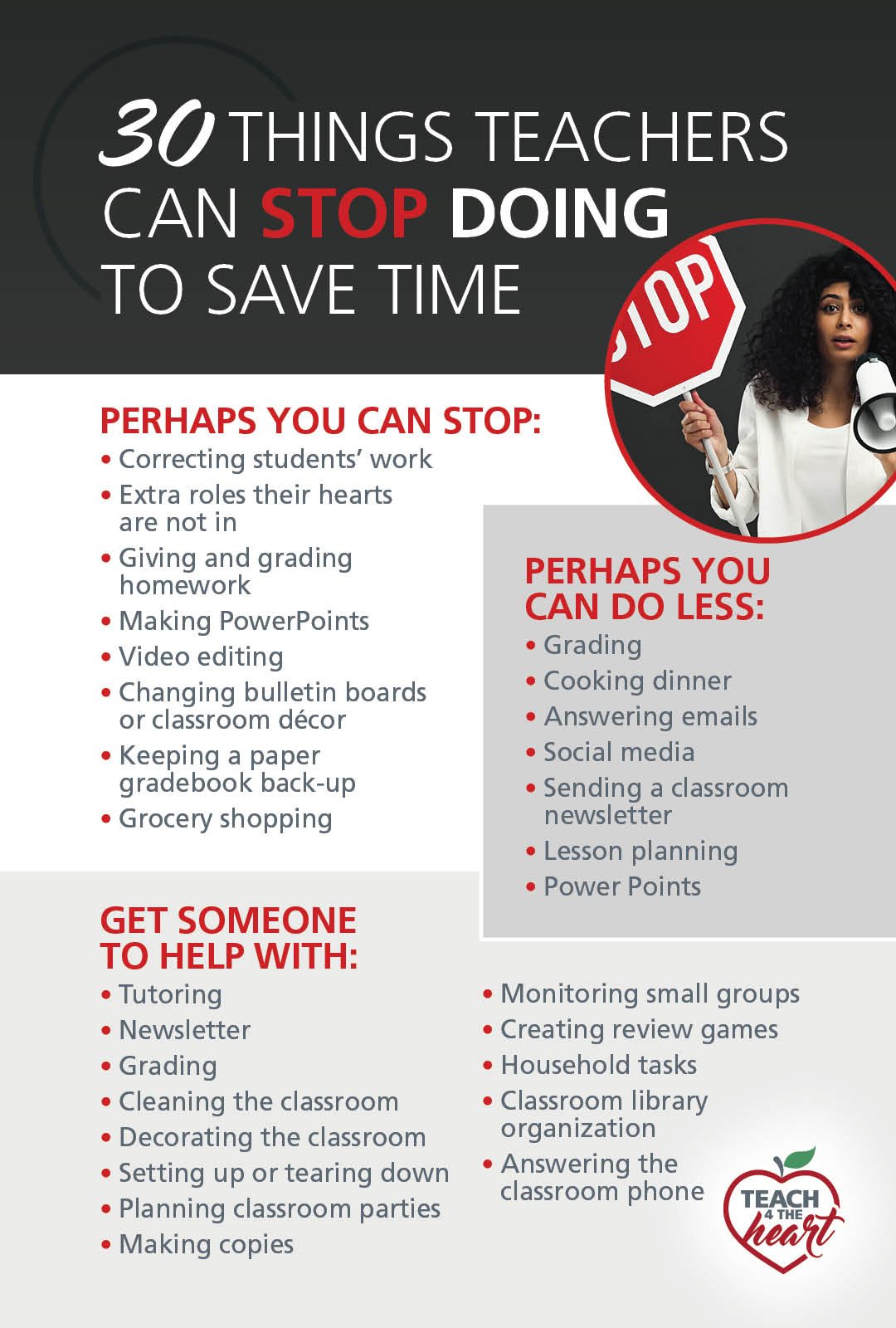
As teachers, we're always having more and more added to our plates - but do we ever stop to take anything off? Listen (or read) to discover thirty ideas of things you can stop doing (or at least do less often).
listen here:
how to save time
In episode 159, we talked about taming your to-do list with the 4 T's. Basically, you write down everything on your to-do list and decide whether to trash (stop doing it), trim (do it with boundaries), transfer (have someone else do), or treasure (keep doing it). You can read more about that system here.
Today, we're sharing examples of things teachers have trashed, trimmed, and transferred to save time. The goal is to find a few of these that work for your unique situation or use this list as inspiration to figure out what you can stop doing.
Pin it for later ⤵
"trash" examples
Here are some things teachers have stopped doing altogether to save time:
- Correcting students' work- Some teachers have stopped correcting student mistakes on test while grading. This is something students can do themselves, even as an assignment.
- Extra roles their hearts are not in- Responsibilities at home, school, or church that you said "yes" to out of guilt and have decided are not the best use of your time can be stopped.
- Giving and grading homework- Some teachers don't give homework at all anymore.
- Making PowerPoints- Creating PowerPoints can use up a lot of time.
- Video editing- Leaving the mistakes in your video and letting them be raw and simple can save so much time compared to making them perfect.
- Changing bulletin boards or classroom décor- You can leave the same one up for the year.
- Keeping a paper gradebook back-up- Just have one gradebook.
- Grocery shopping- Use InstaCart or something similar to do grocery shopping for you.
"Trim" examples
Here are some examples of things teachers are doing way less often:
- Grading- No teacher should be grading everything and almost every teacher could grade less than they currently do.
- Emails- Commit to checking your email 1-2 times a day instead of all through the day. Remove email from your phone so you're less likely to check it on evenings and weekends.
- Social Media- Put specific boundaries around your time spent here.
- Sending a classroom newsletter- Some have stopped doing it altogether and others have switched to sending one every other week.
- Lesson-planning- One simple tip is using a timer to give yourself a deadline so you can stay focused and not go down a rabbit hole.
- PowerPoints- Instead of getting rid of them completely as above, some teachers are making them much more simplified and not elaborate.
- Dinner- Make two day meals, for example, double the recipe and make the meal for both Monday and Wednesday.
"Transfer" examples
These are tasks teachers are transferring to other people. Note that these will always take some training in the beginning, but if you can train someone in the beginning of the year and they can do that task for you the entire year, it's definitely worth it. Wondering how to train someone efficiently? You'll want to check out Tame Your To-Do List that goes into a lot of detail about this.
- Tutoring- Sometimes parent volunteers or older students can help tutor.
- Newsletter- A parent volunteer or paraprofessional could create your newsletter.
- Grading- Students can exchange and grade smaller assignments or an adult helper can take over.
- Cleaning the classroom- Students can be trained on these procedures.
- Decorating the classroom- Instead of stopping completely, you can transfer this to students or parent volunteers.
- Setting up or tearing down- If you have labs or activities that require a lot of set up and tear down, transfer that task.
- Planning classroom parties- A parent volunteer or room mom can plan and coordinate all the parties.
- Making copies- A parent or student can help with this.
- Monitoring zoom or small groups- A parent or paraprofessional can help monitor.
- Creating review games- Students can often help with this by creating questions for the review game. It can be a whole class assignment.
- Household tasks- Is the home all your responsibility? Or are your roommates or family members helping? You can divide household tasks with your spouse and even children.
- Classroom library organization- A student or two can be in charge of this.
- Answering the classroom phone- A teacher has a student answer the phone and then relay the message.
We don't expect anyone to stop doing all of these things, but hopefully you got some ideas for what to stop doing to get some time back. If you're nervous about dropping any of these tasks, think of it as a temporary experiment where you just try it and see how it goes.
What have you stopped doing? Share in the comments to help your fellow teachers!
Transfer EVEN MORE by delegating meaningful classroom jobs to students!
Meaningful classroom jobs not only save you time and energy but also give ownership & responsibility back to your students.
Get the Classroom Jobs Idea List for FREE when you click here.
Want step-by-step support getting your schedule under control??
If you're really struggling with time management, consider enrolling in the Reclaim Your Time 101 course from Teach 4 the Heart. This workshop-style course takes you from stressed & frazzled to prepared & energized - in just one afternoon!
resources mentioned:
spread the word!
Did you find this post helpful? Clue in your fellow teachers by sharing the post directly (just copy the URL) or by clicking one of the buttons to automatically share on social media.

This article may contain affiliate links. This means that if you purchase a resource after clicking the link, Teach 4 the Heart may receive a small commission at no extra cost to you. Thanks for helping support Teach 4 the Heart in this way.




WoW? What are these parent volunteers and paraprofessionals I can transfer some of my tasks to that you speak of?
Just curious, have you asked for parent volunteeers for specific tasks? 🙂 You might be surprised!
I love the idea of the 4 Ts! I think we do that naturally, but I love having an organized system to prioritize my to-do list at home and work. I thought of another T: Tailor. Maybe I can’t do less of something or trim it, but maybe I can tailor or alter it to better suit a need or be more efficient with it. I have added this T to make the 5 Ts and implemented them to discuss during our homeschool co-op staff meetings when we reflect on what’s working and what’s not working. Thank you for this system and for all the amazing podcast episodes that give me inspiration and encouragement as a Director and Teacher, and mom, at our church homeschool co-op!